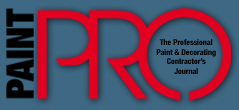
Pricing Structures,
Painting Business,
Painting Conctractor
Estimating for the Painting Contractor, Article #6 of 7, Pricing Structures
by Len Hijuelos
there are a number of pricing structures or methods used, most of which are not very good, and some that I have heard of are downright weird. In a previous article, I said that the take-off should be structured so that the project can be priced by the substrate and the required finishes. What ever pricing structure we use should reflect that and further should be based on realistic appraisals of both labor and material costs.
There are four basic factors that make up a price:
1. Labor
2. Material
3. Overhead
4. Profit
Whatever pricing structure used should be set up to reflect all four of these costs as well as any other special costs that may be unique to a particular project. In this article, we will be discussing three different pricing methods that are in common use within the industry, and discuss some of the advantages and disadvantages of each.
The first method we will talk about is the Unit Price. This is an all inclusive price in that all of the basic cost factors are contained in one price. This is probably the most traditional and most widely used pricing method in the industry. It is not necessarily the best, but it does have the advantage of being simple and fast. The downside is that one tends to get locked into using the same units over and over, making no adjustments for varying job conditions. It also does not lend itself to other uses or provide very much information.
The second method shown (Exhibit Two) is what we might refer to as an expanded or developed unit price, in that the various work processes and cost factors are separated. This obviously requires a little more time to do, but it is more detailed and provides the user with a bit more information. The third method is what we might call a Summary, for want of better term. I have no idea who developed this format, but I first saw it a number of years ago, started using it, and over the years made some modification to fit my needs. This is a detailed structure and obviously takes time to use, but it does provide the user with a great deal of information; it can be helpful in ordering material and is very easy to work into a job cost system. What, in particular, I like about this system is that it tends to make the user more aware of the production rates and material spread rates being use on each individual job. Whichever pricing structure or method you decide to use is still based on the four basic cost factors. Of these, labor, obviously, is the most difficult to handle, and the most difficult to evaluate. Effectively, your labor costs are based on you wage rate and the productivity of your people. When I was doing estimating seminars for the University of Missouri, one question that was repeatedly asked was where does one get production rates from, in fact if you log onto the Painter’s Chat Room, you will see that question in one form or another asked over and over. There are various guides available, but probably the best and most realistic is the PDCA Estimating Guide. The best way is to build your own tables by tracking your own costs of different work processes through several jobs. Material costs, unless you are dealing with industrial or high performance coatings are relatively straight forward. Divide the cost per gallon by the spread rate, which you can get form a technical data sheet, but remember, to allow for waste factor. Incidentally, the numbers used in the exhibits, that is production rates, material spread rates, overhead, etc., do not reflect what any contractor might use. They are more or less based on averages. You will note that I have handled the application of overhead and profit somewhat differently on the three different structures. Any of the ways demonstrated can be used with any of the three structures; you only want to be certain that all of these costs are realistic and are covered somewhere in the final price. As a matter of fact, I don’t use any one of the three shown, but rather put all my costs on a Summary of Cost sheet. Having gone through all of this , and having demonstrated the need for accuracy, and attention to detail, in time, you as ha many experienced estimators, may find the ultimate formula for pricing a job. The next and final article of this series will discuss pricing, overhead and an overview of estimating and management. 
|

